Celebrate Preservation Month This May
Celebrate Preservation Month this May by putting a focus on projects in Roanoke that honor and protect historic spaces while meeting the current and future needs of our community.
The Preservation Month theme is “Harnessing the Power of Place” to honor the countless ways, big and small, that preservation work strengthens our community, breathes new life into neighborhoods, supports a healthier planet, and builds a just and connected society.
Visit the National Trust for Historic Preservation for resources and information to help you celebrate this May!
Get Involved
- Follow us on Instagram and Facebook to learn more about local preservation projects throughout the month of May.
- Share a story of a recent preservation project in the City of Roanoke that you would like to see highlighted this month in the form below.
- Join in celebrating the power of place by telling us about a place that is important to you and how historic preservation is benefitting your life or the life of our community through a social media post with #SavingPlaces and #PreservationMonth!
- Learn more about nationwide historic preservation efforts through the National Trust for Historic Preservation.
Power of Place
Check back here throughout the month of May as we celebrate recently completed historic preservation projects.
2024 Place-Savers
In 2024, the Preservation Month theme was “People Saving Places”. See below the place-savers highlighted in our community that year. Historic place-savers pour their time, energy, resources (and sometimes a great deal of sweat and tears) into protecting places they care about.
- Jordan Bell | Gainsboro Revisited
- Allison Blanton | Hill Studio
- Bill Mason | Architectural Review Board
- Isabel Thornton | Restoration Housing
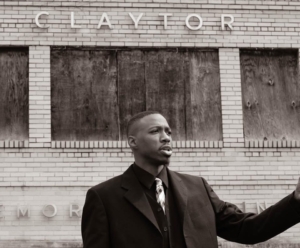
Jordan Bell
Gainsboro Revisited
About Jordan
My name is Jordan Bell. I am a father, son, and brother. I take pride in my community by working with children through my favorite place Apple Ridge Farm. My other passion is history and preservation of that history.
His Work in Historic Preservation
My work started about 7 or 8 years ago. I was blessed to have a grandmother and aunt that enjoyed telling stories of their childhood. They spoke to me about old Gainsboro and one thing led to another and I met Richard Chubb and ever since then I have been attempting to preserve as much of Gainsboro history, especially stories that I can.
Involvement in Historic Preservation
Jordan has been involved with historic preservation for about 7 or 8 years.
What Historic Preservation Means to Him
It means everything. Without historic preservation we cannot produce a future. It gives many people a sense of worth.
The Importance of Historic Preservation
Preservation is important to me because it helps to tell us where we come from as African American people.
Favorite Parts of Roanoke History
My favorite place of course is Gainsboro. The home of Oliver Hill, Edward Dudley, and Dr. James H. Roberts are next to each other. My favorite piece of history is the Claytor property. The old Claytor Memorial Clinic building. All of my favorite historical places are in Gainsboro. Oral history is my favorite part of historic preservation. I count it as an honor for someone to tell you their story.
Encouraging Historic Preservation
Jordan believes the community should invest in their neighborhoods to encourage historic preservation in the City of Roanoke.
Spelling Success in Historic Preservation
Preserving Gainsboro will spell success for historical preservation in Roanoke. Gainsboro history is what made and makes Roanoke the Star City. If we do not preserve Gainsboro then we are not doing our part in preserving American history.
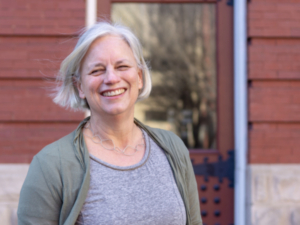
Alison Blanton
Hill Studio
About Alison
I grew up in Texas and first became interested in historic preservation when the small courthouse town of Georgetown (one of the pilot Main Street towns) started renovating storefronts and painting their fire hydrants like Revolutionary War soldiers for the Bicentennial celebration in 1976. After attending Uva and the University of Texas for undergraduate, I decided to return to Uva for a graduate degree in Architectural History and pursue a career in historic preservation. After working in Washington DC and living in Richmond and Williamsburg, I moved to Roanoke in 1993 with my husband and three children and have lived in the Raleigh Court neighborhood since that time. Starting in 1994, I have worked at Hill Studio, a multi-disciplinary design firm, as the Preservation Studio Director and currently as Senior Preservation Fellow. I provide expertise on a wide range of cultural and historic preservation projects throughout Virginia and other states. My work over the last 30 years for Hill Studio includes historic tax credit projects, National Register nominations, historic resource documentation, design guidelines, preservation plans, façade improvements, Section 106 Review, and interpretive plans. I am a Trustee of the Roanoke Valley Preservation Foundation and Preservation Virginia as well as a Board Member of Friends of Mountain View and Friends of Old Lick Cemetery and also am assisting the Friends of Washington Park.
Her Work in Historic Preservation
Over the years, I have worked to promote historic preservation in Roanoke in several different capacities. Through my professional work with Hill Studio, I have surveyed and nominated numerous historic districts to the Virginia Landmarks Register and National Register, including historic districts in Downtown Roanoke, Gainsboro, Henry Street, Grandin Road, Roanoke River & Railroad Industrial area, Riverland, Wasena, Melrose-Rugby, Southwest, and Belmont neighborhoods as well as several individual property nominations, including Burrell Memorial Hospital, Black Horse Tavern, the Virginia Can Company/Heironimus Warehouse, the Roanoke Health Department, and the American Viscose Plant. . I have also worked with developers and property owners to renovate over 50 historic buildings in Roanoke for adaptive reuse by successfully facilitating the use of state and federal historic tax credits. Some of the more notable projects I have been involved with include the City Market Building, the Higher Education Center, the Link Museum, the Jefferson Center, Center in the Square, the Claude Moore Culinary Institute, the Dumas Hotel, the Grandin Theater, and the Patrick Henry Hotel. I also provide historical research and preservation guidance on a variety of local projects undertaken by Hill Studio. As a member of the Roanoke Valley Preservation Foundation, I have advocated for the preservation of endangered buildings, recognized worthy projects annually with the Kegley Preservation Awards, developed numerous walking and biking tours of downtown and various neighborhoods, developed interpretive signage, and participated in workshops and presentations to local civic, business, and neighborhood groups. I also served on the Roanoke City Architectural Review Board for 16 years. Currently, I am working with local non-profit organizations to preserve and restore the Fishburn Mansion at Mountain view, the Old Lick Cemetery, and the Washington Park Caretaker’s House.
Involvement in Historic Preservation
Since 1985 and in Roanoke since 1994.
What Historic Preservation Means to Her
Historic preservation means preserving the historic and cultural resources of a place in order to understand and appreciate the people and events that shaped its unique development. I believe that historic preservation gives a place a unique sense of identity that serves to connect people to that place as well as to each other.
The Importance of Historic Preservation
I believe that historic preservation contributes to our quality of life in many intangible ways. Not only does it provide people with a sense of place and community, but the built environment of our past informs us and also embodies the values of our predecessors. Historic preservation is also environmentally and economically “green” as it keeps building materials out of the landfill and puts people to work with a greater emphasis on labor than materials.
Favorite Parts of Roanoke History
I like the different historic neighborhoods of Roanoke the best as each one has its own history and architecture that reflect the various people and times that characterize the overall development of the city. In general, these neighborhoods represent strong and healthy communities that, when preserved, can continue to provide a good life to their residents.
Encouraging Historic Preservation
I would like to see City leadership better integrate preservation into their planning process from the beginning so that the historic resources are seen as valuable assets (rather than liabilities).
Spelling Success in Historic Preservation
City leadership combined with enabling the property owners with the resources necessary to be good stewards of their historic properties. The necessary resources include education, financial incentives, and accessibility to affordable historic materials and trades people.
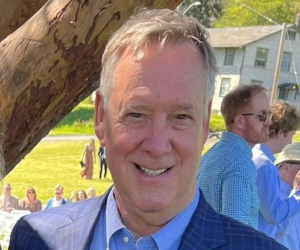
Bill Mason
Architectural Review Board
About Bill
My wife and I moved to Roanoke with our two children in 2000. They were educated in Roanoke City Schools and have moved on, we moved out of South Roanoke to 1st Street in OSW 5 years ago. I’ve worked in the building industry, mostly in the HVAC business, for over 30 years.
His Work in Historic Preservation
Older structures appeal to me because their build quality is outstanding, they have so much character, and offer significant investment opportunity. So, preserving them… affordably…became a passion of mine. We rehabbed two properties in OSW – one of which we rehabbed twice! – and that is our home today. We utilized local, state, and federal historic tax programs to finance the projects, but it was still expensive. Encouraging our ARB to modernize some guidelines and make rehabilitating these structures more attainable became a goal. I’m proud to say that we have adopted some modifications to the guidelines that will provide clarity and streamline the rehabilitation process. Hopefully, encouraging others to take the plunge as we did 20+ years ago.
Involvement in Historic Preservation
Bill has been involved in historic preservation for 22 years.
What Historic Preservation Means to Him
Respect and admiration for the craftsmanship of prior generations and the appreciation of the families and neighborhoods that once were. Thinking about the Old Gainesboro business hub, the folks walking from their homes in SE to work at American Viscose. A way of life has passed us by.
The Importance of Historic Preservation
It is good for the environment to take care of these buildings, preserving them preserves our culture.
Favorite Parts of Roanoke History
Highland Park! A beautiful gem in the middle of a historic neighborhood. The building boom in the late 1800s and early 1900s must have been spectacular. The road up the front of Mill Mountain.
Encouraging Historic Preservation
Enhance tax savings – especially for owner occupancy. More stimulus for investment.
Spelling Success in Historic Preservation
It’s happening now, with apartment buildings in Norwich, all over downtown, the American Viscose property. The historic designation for SE, and Norwich, and in the existing H1 & H2 districts, we have demonstrated that we will listen to input and move to improve our guidelines and processes to meet our neighbor’s best interest.
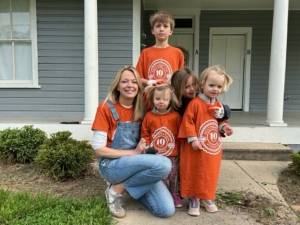
Isabel Thornton
Restoration Housing
About Isabel
My name is Isabel Thornton and I’m a Roanoke native now working in historic preservation through the nonprofit Restoration Housing. I created this nonprofit to address the many older, historic homes that I saw in and around Roanoke that were falling down and needed reinvestment.
I actually don’t live in an older home (!) as I live on my husband’s family farm in Botetourt. I love living on a farm but I likewise love working in a city and studying our city’s history/thinking of ways to improve upon its history in the work that Restoration Housing does. I have four small children and I created this career largely as a way to build inherent flexibility into my work so that I could also raise a family.
Her Work in Historic Preservation
To date, Restoration Housing has completed seven historic rehabs throughout Roanoke’s older neighborhoods (Old Southwest, Mountain View, Northwest, and Southeast) with two more in the pipeline. With each project, we’re taking a formerly vacant structure that is usually in a severe state of disrepair and we’re investing large sums of money (usually through grants, donations, and historic tax credits) to bring them back to life and make them practical and viable spaces again. The other key piece to our mission is that we own and operate each property thereafter in perpetuity to ensure that they are safe, affordable, and well-maintained. It is so important not only that historic buildings receive this kind of reinvestment but also that there is a stewardship plan in place that will ensure that they’re well-maintained and won’t fall back into disrepair a few years down the line.
Involvement in Historic Preservation
I studied Architectural History as an undergrad in college at UVa but my real entrance into Historic Preservation began in graduate school at the University of Southern California where I received a Masters in Historic Preservation. While there, I worked for a subcontractor specializing in the preservation of historic stones and brick. That was my first official experience working on the technical side of preservation. I realized there that the technical work of salvaging a terracotta parapet wall was not my dream job (though interesting nonetheless) and I subsequently went to work with an affordable housing developer specializing in projects that used historic tax credits. I realized there that I was most interested in building development and, specifically, using historic tax credits as a tool for subsidizing construction costs and keeping rents affordable.
What Historic Preservation Means to Her
Historic Preservation has long been a movement that connotes activism but is has historically been a more large-scale public facing form of activism like saving Penn Station. I’m interested in how historic preservation can be a tool for social change on a more local level- reinvesting in underserved neighborhoods that have long lacked public and private investment. And likewise as a tool for honoring histories that don’t always make the history books like a small vernacular house in Southeast Roanoke that has a unique story to tell, generations of families who have lived there and loved the community there and worked for the nearby railroad, but that don’t always get as much attention because they’re not connected to a famous person or a famous architect. There are so many houses worthy of historic preservation not because of their illustrious lineage but because they are meaningful to our city’s history and they still have a practical purpose to serve once they’ve been restored.
The Importance of Historic Preservation
I have always valued history but it’s so much more than that for me. It’s the integrity of materials of older buildings and how much more well-made they were back before World War II. It’s also the negative environmental impact I see from so much development outward (sprawling) on greenland (or undeveloped land). I much prefer to see development done on existing buildings, using existing infrastructure, or on vacant lots so that we are not building outward in a thoughtless and often cheap and aesthetically displeasing way.
Favorite Parts of Roanoke History
I love so much of Roanoke’s history from its rail town origins to its unique Appalachian heritage that sets us apart from Richmond and the rest of the state. Perhaps most of all, I think the history of Gainsboro is the most fascinating part of our story. Learning about the prominent African American political and social figures who grew up and worked in Gainsboro continues to amaze me. It’s a fascinating neighborhood.
Encouraging Historic Preservation
A lot of homeowners and landlords might want to preserve their buildings that have historic siding, windows, and rooves but struggle with the costs to do so. I think a great encouragement would be some sort of grant funding or endowment fund that could help homeowners and landlords with these expenses. Historic Preservation is expensive and it’s important to make it attainable to all incomes.
Spelling Success in Historic Preservation
I think more Historic District designations would be a wonderful way to encourage more preservation throughout Roanoke and to see more success stories. We already have so many great examples here from our downtown redevelopment to our small villages like Wasena and Grandin. It would be great to see more expansions of these developments in the Melrose/Orange area (like with a historic district along Lafayette Boulevard or an expansion of the existing district of Melrose Rugby) or in the Loudon neighborhood.
If you’d like more information, please contact:
Historic Preservation
540-853-1730
historicpreservation@roanokeva.gov
Power of Place
Learn about local historic preservation projects and how these places are being adapted to meet present and future needs.
Check back each week for new story to be posted!
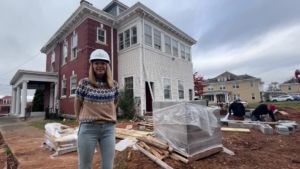
1729 Patterson Ave SW
Restoration Housing
About Property Developer
I’m Isabel, the Executive Director of Restoration Housing – a nonprofit affordable housing developer with a focus on historic preservation of vacant and blighted properties.
Learn more about Isabel and her background under the 2024 Place-Savers tab.
Why she chose to work on a historic property.
Older homes that need a lot of work are our specialty, and we love to find forgotten houses that are so neglected they’re beyond the scope of most buyers. These are the properties most in need of investment, and as a nonprofit, we’re in a unique position to take them on. We can raise money, apply for grants, and leverage historic tax credits to make these restorations possible.
The preservation work at 1729 Patterson Ave SW.
The building at 1729 Patterson Ave SW is two-and-half story structure built circa 1916 in the colonial revival style. It was originally designed as a single-family home for a Roanoke business leader. The foundation is made of rusticated block, and the exterior features a brick façade with wooden soffits and decorative dentil molding. The hipped roof is covered in slate and includes two dormers on the front and two on the back, along with hidden gutters and two brick chimneys. A one-story porch wraps around the front and side, and it is supported by twelve tapered, fluted Ionic columns. Architectural highlights include brick quoins at the corners, double-hung wooden windows with multi-pane upper sashes, wooden trim, and jack arches above the windows, each featuring a white keystone.
This project was actually unique for Restoration Housing, as it didn’t need nearly as much work as our other projects have. The previous owner performed a lot of preventative maintenance and kept the property in fairly good condition. The bulk of our work went into outfitting it as a residential treatment facility, which meant adding a fire suppression system, building a new ADA-compliant addition in the rear first floor, remodeling the kitchen and bathrooms, and completing the typical historic work that we do – exterior trim restoration, refinishing floors, repainting throughout, and updating mechanical and electrical systems. Ultimately, we did have to rebuild the front porch, as it was rotten in many sections. Watch our Hard Hat Tour video highlighting the restoration work done on the property.
The project went before the City’s Architectural Review Board (ARB) for approval of the exterior work. Contractors do not provide a guarantee or warranty for the type of roofing previously installed on the porch roof due to its potential for water intrusion. The ARB approved an alternative roofing style to support the continued maintenance and preservation of the property.
The 1729 Patterson Ave SW property has a rich history that reflects much of the history of the City and the neighborhood. See links to a video series at the bottom of the page sharing the history of the property.
The impact of the project on the people that live in this historic property
The name of the project is The Grove on Patterson, and it’s a residential treatment facility for pregnant and postpartum women and their newborn babies. It can hold up to sixteen women and sixteen infants at a time and serves as a beautiful and welcoming home for women going through a very difficult time in their lives. Restoration Housing is proud to be a partner in the project as we believe that safe, stable, housing is critical for everyone but especially for new mothers and for those going through substance use treatment.
This property truly feels like a home filled with light and warmth and you can tell that it’s been cared for over decades. It is such a stark contrast to what we think of when you hear the word “facility” and it’s such a welcoming departure from that term to offer a space that is peaceful and healing. This choice was very intentional with our partners as we knew we didn’t want to build something new that would feel institutional and cold.
The impact of the project on the local community
There is a community impact anytime that a property receives reinvestment after years of being vacant or if the neighborhood more broadly has lacked private and public investment. You can see that in the pride of place that people feel after a building is no longer vacant. Beyond that, the service that this project is bringing to the community creates this double impact of both bringing the house back to life and offering something of value in its treatment program for a very vulnerable population within Roanoke.
The Grove on Patterson is replacing the services previously provided by Bethany Hall, a treatment facility that operated for 52 years in Roanoke before closing in 2022. Bethany Hall treated pregnant and postpartum women with Substance Use Disorder and saw a 70% recovery rate among its graduates. Success for The Grove on Patterson will mean achieving a similar – if not higher – recovery rate for its graduates. In-patient facilities like this are rare but incredibly impactful for recovery outcomes.
With an anticipated number of 56 women and babies going through the facility each year, we hope to see a direct impact in lowered rates of Neonatal Abstinence Syndrome from our local hospital system and fewer children entering foster care within the region within five years.
While recovery from Substance Use Disorder can be transformative for mother, baby, and extended family, the indirect community impact is also substantial. Women in recovery are more likely to bear children without health issues, provide stable home environments, and maintain custody. Stable homes and reductions in foster care have a direct impact on reducing crime, increasing educational attainment, decreasing homelessness, and lowering the need for public assistance.
By providing pregnant women with an effective path to recovery, we will help hundreds of pregnant and postpartum women achieve recovery. We will also prevent hundreds of newborns from facing prolonged hospitalization, long-term health issues, unstable family settings, and foster care placement.
Why is historic preservation important to her
Historic preservation is an excellent tool for reinvestment in underserved areas. These parts of Roanoke are rich in history but often lack public and private investment. What better way to help revitalize a neighborhood and community than by honoring the historic built environment while also bringing something of service and value to the space?
Her other favorite historic properties/places in Roanoke
I love Fire Station 1 and the work that Dale did there. I’m also very partial to Wasena and the Grandin Road area. I grew up off Grandin and still find the village there to be extraordinary. Likewise, Restoration Housing’s office is in Wasena, and we’re thrilled by the work John Garland has done there (building off of Brent Cochran and Ed Walker’s work as well) to help reinvigorate this community.
Video Series on History of Property
Part 1 – An Immigrant from Ireland
Part 2 – The Heyday of Patterson Ave
Part 3 – The Big Change
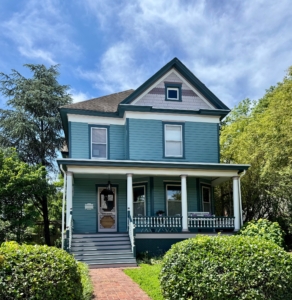
Old Southwest
Preservation Stories
Preservation happens on a large and small scale every day in our community. Read below about the preservation work in Old Southwest including grassroots efforts to establish the historic district, the thoughtful restoration of a cherished family home, and the ongoing stewardship of the historic Alexander-Gish House.
History of Old Southwest
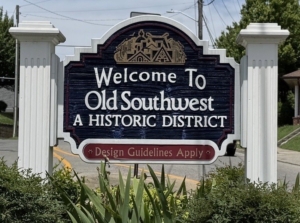
The Old Southwest neighborhood is bordered by Marshall Avenue SW to the north, Jefferson Street to the east, the railroad to the south, and 10th Street SW to the west.
Originally developed at the turn of the 20th century, Old Southwest was Roanoke’s first “suburban” neighborhood, located on the outskirts of downtown. As the City grew and Norfolk and Western Railway chose to locate in Roanoke, large and elegant Victorian mansions were built and marketed to railroad executives and the region’s more affluent families. Over time, more modest yet eloquent homes were constructed, along with apartment buildings and small neighborhood commercial businesses, contributing to the area’s architectural and cultural diversity.
From the mid-1950s through the early 1980s, Roanoke’s housing patterns followed the national trend of outward migration from the urban core to suburban areas with larger lots and development oriented around the automobile. As a result, the southwest area of the City experienced disinvestment and neglect, and many historic homes were demolished to make way more automobile oriented apartment buildings and offices. By the 1970s, crime and blight came to define the neighborhood, and its origin as one of the elite early suburbs was virtually unknown to younger Roanokers.
In response, a small group of community advocates organized to preserve the area’s heritage. With the assistance of a federal grant, they worked to establish a National Register Historic District covering portions of southwest Roanoke and a local historic zoning district for Old Southwest and parts of the Mountain View and Hurt Park neighborhoods (the Gainsboro District came later – look back next week for more on the Gainsboro District!).
The story of Old Southwest today offers hope and guidance to other inner rung City neighborhoods, as well as other neighborhoods across the country. As revitalization has reached plateaus that were once deemed insurmountable, investment continues to increase, with sale prices and
property values following suit. Today, Old Southwest is known as a vibrant, thriving neighborhood. It is well regarded for its walkable proximity to downtown, blend of commercial and residential uses, scenic Highland Park, and stunning, historic architecture.
Family Home on Albemarle Ave
Submitted by the property owners

Why they chose to live in and preserve a historic property.
We love Roanoke and the central location of the Old Southwest neighborhood. It’s an easy walk or bike to downtown, the greenway, Highland Park, and even Mill Mountain, so the location is important to us. We also love the stories and character that have built up over the 120 years since our home was originally constructed. The craftsmanship and detailing of our home show the care and thought that were put into the design and that inspires us every day.
The preservation work at their home
Our home was built in 1905 in the Queen Anne Victorian style. The front porch required extensive repairs due to a leaky roof, so we replaced the metal roof, rebuilt the internal gutters, replaced the tongue and groove wood flooring, and had some trimwork, railings, and lap siding custom milled by Ideal Lumber. We were able to retain most of the beadboard ceiling and railings. We had a great team led by Emmanuel Construction who were very respectful of the historic detailing and preserved as much as possible. The wood lap siding was also in need of repainting so we picked a color scheme that highlights the architectural style and historic detailing.
This project brought new life to the house and it makes us smile each day as we come home from work and school. It also helps to no longer dodge rotten floor boards or dripping water!
The impact of the project on the local community
While it’s a relatively small change, we hope it makes the walk down the street a bit more enjoyable for our neighbors and helps to preserve a piece of Old Southwest history.
Why is historic preservation important
Historic buildings tell a story and have an authenticity that can’t be replicated. This can be felt from something as small as a door knob to as big as a factory. Preserving entire districts is also crucial in maintaining scale, context, and relationships that otherwise would disappear based on market forces.
By preserving these structures and places, we save parts of our past for future generations to experience and enjoy, as well as honoring the craftsmanship and embodied energy that have been built to last for generations.
Community Preservation with the Alexander-Gish House

History of the Alexandar-Gish House
The exact age of the Alexander-Gish house is undocumented, but it is undoubtedly one of the oldest dwellings in Roanoke. The original portion of the house is believed to have been constructed around 1818, possibly as a wedding gift for Michael Howbert and his bride, Hannah Peffley. The land was surveyed in 1776 for the Alexander family and passed through several owners before becoming known as “Gish Woods” under the care of Nannie Coon and her husband, Samuel Gish.
In 1901, the City of Roanoke purchased the property, and it became Roanoke’s first park. The house was modified in the 1920s, changing its orientation to face the road through Highland Park. It remained occupied by a park caretaker until 1974 when it faced demolition. Thanks to the preservation efforts of Old Southwest, Inc., the structure was saved and rehabilitated. Today, the Alexander-Gish House serves as the headquarters of Old Southwest, Inc., hosting meetings, classes, and workshops. Ongoing renovations are funded through rental income, continuing the mission of historical preservation.
Preservation Work and Community Impact
Submitted by neighborhood leader of Old Southwest Inc.
Today, Old Southwest Inc. (OSW Inc.), an all-volunteer neighborhood 501(c)3, oversees and finances all aspects of preservation, maintenance, and security/safety for the historic Alexander-Gish House and an acre of surrounding land in Highland Park. The house and land are owned by the City of Roanoke, and they serve as a vibrant and active OSW community center for our diverse, historic neighborhood. They are the gathering place for regular community meetings and free social, cultural, educational, community-improvement, and special-interest events and activities—both for the OSW neighborhood and, at times, for the broader Roanoke public at large. To our knowledge, Old Southwest Inc. is the only neighborhood community alliance that financially underwrites day-to-day costs, surveils, and structurally maintains its own community/recreation center at no cost to the city. This arrangement has been so since the 1980s when this city-owned property was slated for demolition and OSW Inc. (then known as the OSW Neighborhood Alliance) raised funds and oversaw its rehabilitation/preservation. OSW Inc. is proud to be part of a creative and mutually-advantageous collaboration with the City.
OSW Inc. relies on volunteerism, as well as active and creative fundraising, to achieve the required level of support to maintain this facility for safe and inviting public use. Annual day-to-day costs average approximately $10,000-$12,000. This figure does not include any costs for repairs or improvements. Fundraising efforts, accomplished completely by neighborhood volunteers, include: managing the rental of a small studio apartment in the house (adding in a small way to the city’s affordable housing inventory), promoting and managing limited public event rentals (just enough to meet expenses, while not interfering with the house being available for free community/public events), and an annual Parlor Tour of Historic Homes fundraiser that attracts hundreds of people from the area to the OSW neighborhood. The fundraiser raises awareness and appreciation for the historic Alexander-Gish House, urban historic preservation in general, and the vibrancy of this historic city neighborhood as a desirable urban area in which to live, work, play, and invest as part of the City of Roanoke. The house is open to the public during the Parlor Tour fundraiser, serving refreshments and various arts and culture entertainments.
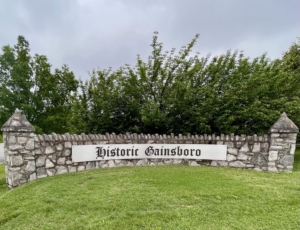
Historic Gainsboro
Preservation Stories
Read below to explore the Gainsboro neighborhood’s deep historical roots, the life-changing impact of a homeowner rehabilitation program, and the legacy of the Gainsboro Library. Together, these efforts reflect a broader movement to honor Gainsboro’s past while investing in its future.
Historic Gainsboro
The Gainsboro Historic District is bordered by Wells Avenue to the south, Patton Avenue to the north, Commonwealth Avenue to the east, and Jefferson Avenue to the west. The district also includes the historic Gainsboro Library, located at the corner of Gainsboro Road and Patton Avenue SW.
The Gainsboro neighborhood was the first area of the City to be developed by settlers with Town of Gainesborough established in 1834. In the 1880s, following the establishment of Norfolk and Western railroad in Roanoke, the historic Gainsboro District and surrounding neighborhood was developed into Roanoke’s largest major housing development. It was originally constructed to house white residents employed in mid-level professional positions with the railroad.
In the 1910s, the City adopted a zoning ordinance that restricted where people could live based on race. Gainsboro became one of the few neighborhoods where African Americans were permitted to reside. In the 1917 Supreme Court case Buchanan v. Warley, zoning based on race was deemed unconstitutional, and the ordinance was no longer enforceable. However, the racial pattern and distribution remained in place through unofficial social boundaries.
Over time, Gainsboro evolved into the heart of black life in Roanoke, and nearby Henry Street became a thriving cultural and commercial hub. The neighborhood was home to numerous black-owned businesses, medical facilities, churches, and civic organizations.
During the 1950s and 1960s, this vibrant community was shattered by urban renewal projects that displaced residents and businesses. Across Gainsboro and Northeast Roanoke, these efforts led to the demolition of over 1,600 homes, several schools, 24 churches, and more than 200 businesses. Additionally, the construction of I-581 further isolated Gainsboro by physically separating the neighborhood from the rest of the city.
Today, the Gainsboro Historic District remains home to many landmark buildings that connect Roanoke to its past. Thoughtful preservation of these historic properties can provide a strong foundation for the neighborhood both now and into the future.
Homeowner Rehab Program in Gainsboro Historic District
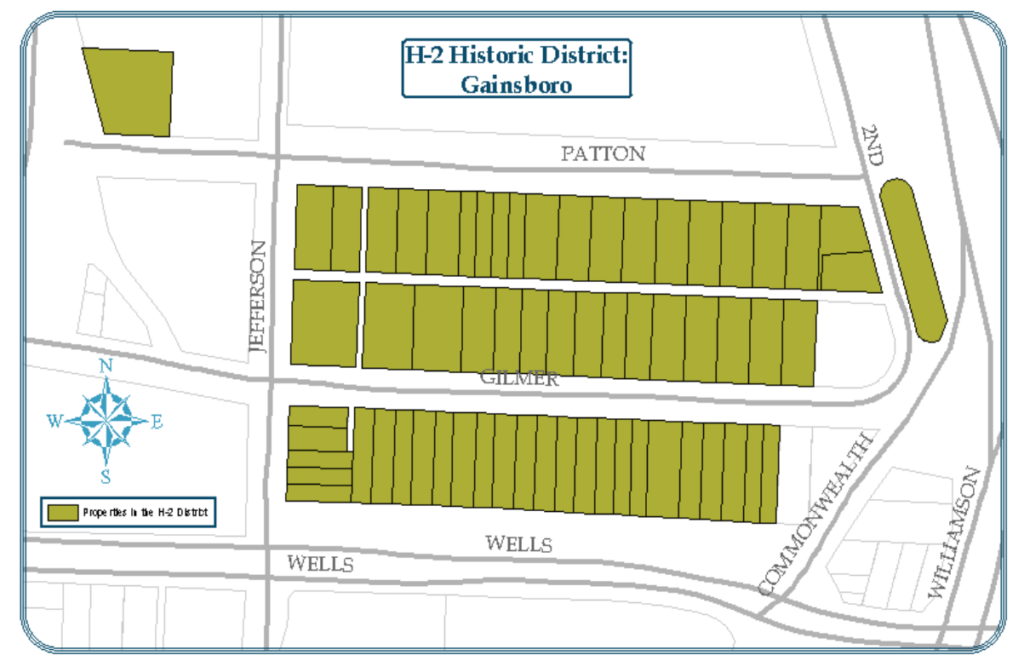
Responses below provided by Kendall Cloeter, Executive Director of Renovation Alliance
About the program and the partners within this effort.
Renovation Alliance is partnering with the City of Roanoke and the Historic Gainsboro Preservation District to reinvest in the Historic Gainsboro neighborhood through the rehabilitation and preservation of its owner-occupied homes. Leveraged funding from the City of Roanoke’s Healthy Homes Production Grant is being used to address health hazards within each home served.
Why they chose to work on the historic properties.
Under its general home repair for neighbors in need program, Renovation Alliance works to lift the quality of owner-occupied housing throughout the Roanoke Valley area by providing free critical and necessary home repair services. When we learned of this effort through a community partner and leaders of the Historic Gainsboro Preservation District, we were excited for the opportunity to support the Historic Gainsboro neighborhood and serve the community.
Preservation work within Gainsboro
Four owner-occupied homes within the Historic Gainsboro neighborhood have been identified for inclusion in this project thus far. Our construction team has reviewed the homes and worked with the homeowners to develop a proposed scope of work to rebuild warm, safe, dry, accessible, and healthy homes while contributing to the long term preservation of the homes and the owners’ ability to age-in-place. The repair and rehabilitation work identified for these projects include structural repairs including foundation work and roof replacements and improvements to systems within the home including electrical, plumbing, and heating and cooling. To enable homeowners to remain safely in their homes for as long as they would like, Renovation Alliance team members worked with the homeowners to identify necessary accessible home modifications to include accessible bathroom renovations, installation of chair lifts, and construction of accessible ramps.
The impact of the projects on the people that live in these historic properties
Thanks to this partnership, individual homeowners and their household members will be able to reside in safer, healthier homes and to remain in their home and community safely, independently, and comfortably as they age.
The impact of the projects on the local community
This project benefits the local community through the preservation of existing affordable housing and contributing to a more livable Roanoke Valley.
Why historic preservation is important
Repairing existing housing stock remains the most impactful and cost-effective strategy for addressing housing stability and affordability concerns.
Other favorite historic properties/places in Roanoke
Renovation Alliance’s office is located in the Southwest Historic District and most days I take my dog, Franklin, on a walk through the neighborhood during lunch. We have a usual route now that has allowed us to get to know many neighbors and I just enjoy hearing their stories and experiences – especially updates on their home repair projects on their 100+ year-old homes.
Gainsboro Library
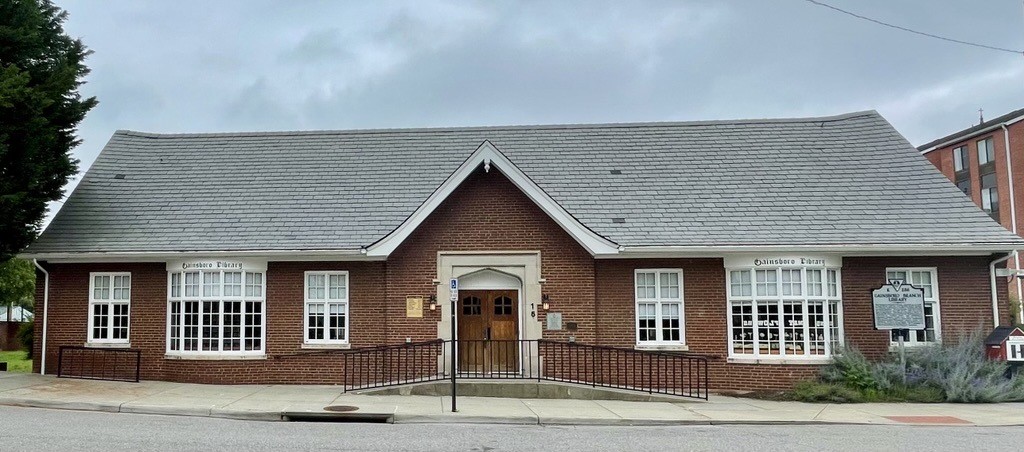
The Gainsboro Branch Library was established through the efforts of local Black activists, and it was the first public library for African Americans in western Virginia and the second in the state. It originally opened in December 1921 in the Odd Fellows Hall at 446 Gainsboro Avenue NW, before moving to its current location at 15 Patton Ave NW in May 1942. In 1996, the library was listed on the National Register of Historic Places, and it later became part of the City’s Gainsboro Historic District.
The current library building, constructed between 1941 and 1942, is a beautiful example of Tudor Revival architecture. Designed by the architectural firm Eubank and Caldwell, its red brick façade, gabled roof, arched entrance framed in rusticated limestone, and two bays of bowed windows give the structure a timeless charm. The design complements Tudor style of the nearby Hotel Roanoke, creating a cohesive architectural feel in the neighborhood.
Throughout the 20th century, the library served as a vital center for Black intellectual and social life, hosting lectures, conferences, reading clubs, and exhibitions. Much of this legacy is owed to the tireless work of Virginia Young Lee, who served as librarian from 1928 to 1971. Lee inspired generations of children to develop strong reading skills and curated a regionally significant collection of Black literature, historical texts, and ephemera. Despite pressure from City officials in the 1940s to remove some of this material, she ensured continued access by preserving the collection in the library’s basement. Today, the Virginia Y. Lee Room honors her contributions and houses this important collection.
Recent renovations have helped the historic library evolve to meet the changing needs of the community. A major renovation in 2009 nearly doubled the building’s size and introduced a new meeting room, a dedicated teen space, and enhancements to the Virginia Y. Lee Room, making the library more welcoming and functional. Further improvements in 2020 continued this momentum, ensuring the facility remains a vibrant and essential resource for future generations.
Sources:
- City of Roanoke. (2003, March). Gainsboro neighborhood plan. https://www.roanokeva.gov/DocumentCenter/View/1232/
- Department of Historic Resources. (2023). Gainsboro Branch Library. Roanoke, VA.
- Gainsboro History Project. (2025). Roanoke Higher Education Center. https://gainsborohistoryproject.org/
- National Park Service. (2005, November). Gainsboro Historic District (No. 05001276). https://www.dhr.virginia.gov/historic-registers/128-5762/
- National Park Service. (1996, December). Gainsboro Library (No. 96001448). https://www.dhr.virginia.gov/historic-registers/128-0256/
- Nelson, R. K., Winling, L, et al. (2023). Mapping Inequality: Redlining in New Deal America. Digital Scholarship Lab. https://dsl.richmond.edu/panorama/redlining
While you’re here…
We are currently seeking community feedback for the following projects. Please take a minute and share your ideas!
Belmont-Fallon Target Area
What is the Belmont-Fallon Target Area? For nearly 20 years, Roanoke has concentrated its community development funding into a single neighborhood to increase its impact. In 2019, the City selected the Belmont and [...]
Welcoming Roanoke
What is Welcoming Roanoke? Roanoke was among 13 communities selected by New American Economy (NAE) and Welcoming America to receive awards through the Gateways for Growth Challenge. As part of this award, Roanoke [...]
Brownfield Redevelopment Program
What is the Brownfield Redevelopment Program? Roanoke’s Brownfield Redevelopment Program is a component of the City’s efforts to encourage investment in and rejuvenation of its core neighborhoods. Brownfields are [...]




